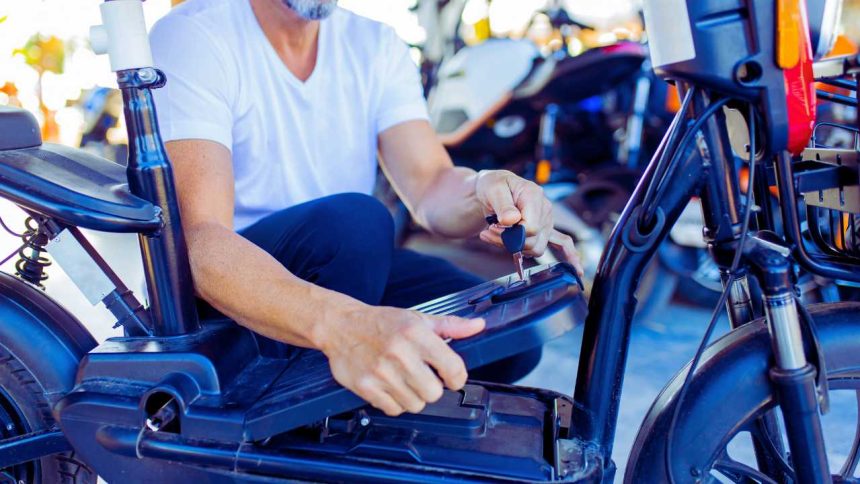Electric scooters provide a fun and environmentally friendly way to get around. However, like any battery-powered device, their lithium-ion batteries can run into issues over time that affect range and performance. Thankfully, there are several DIY steps you can take to fix an electric scooter battery and restore it to working order.
Test and Diagnose the Battery
Use a voltage tester to check if the charge is dropping quicker than expected while riding.
The first step is to diagnose the battery issue. Here are some common electric scooter battery problems and how to test for them:
Draining Too Quickly
If your electric scooter’s battery life seems to be significantly shorter than when it was new, the battery may be wearing out. Use a voltage tester to check if the charge is dropping quicker than expected while riding.
Not Charging
If the scooter won’t charge at all, first check that the charger is working by trying a different wall outlet or testing it with a multimeter. If the charger is fine, the issue likely lies with the scooter battery itself.
Swollen Casing
Lithium-ion batteries can swell up over time. Check for any bulging parts of the battery case, which indicates contaminated or damaged cells.
Open Up the Battery Compartment

Once you’ve diagnosed the issue, you’ll need to open up the battery compartment to access the cells. This usually just involves unscrewing a couple of panels or removing adhesive strips. Refer to your scooter manual if you’re unsure.
Be very careful when handling electric scooter batteries and never try to puncture or damage the battery casing.
Check Connections and Clean Contacts

If the battery isn’t charging properly, the first thing to check is the connector between the battery and scooter. Unplug the connector and check for any debris, rust or bent pins. Clean out the ports and plug it back in firmly to ensure a good connection.
You can also clean the metal battery contacts using rubbing alcohol and a cotton pad or swab. This removes any built-up residue so electricity can flow efficiently between cells.
Check Voltage of Individual Cells

The next step is checking battery voltage at the cell level using a multimeter. Place the black probe on the battery’s negative terminal and touch the red probe to each cell in sequence. Healthy cells should have a voltage between 3.6-3.7 volts when fully charged. as per manufacturer guidelines.
If you find any cells with significantly lower voltage, this indicates they are worn out or damaged and can’t hold a proper charge. They will need to be replaced.
Replace Faulty or Imbalanced Cells

You can usually buy matching replacement cells online for your particular electric scooter battery model, from reputable battery retailers.
If certain lithium-ion cells are worn out or damaged, you can usually buy matching replacement cells online for your particular electric scooter battery model. Carefully uninstall the bad cells and install the new ones in their place. Make sure the voltage matches the rest of the pack.
You can also try reconditioning old cells with low capacity using an lithium battery restore machine. This applies controlled charges and discharges to reactivate the active materials inside.
Reassemble the Battery Pack
Once any faulty cells have been replaced, carefully reassemble the battery pack according to its original configuration. Make sure wires and connectors between parallel groups are secure. Seal the battery compartment back up tightly.
It’s a good idea to apply some dielectric grease on the battery connections to prevent future corrosion issues.
Re-Balance the Pack
After rebuilding or replacing any cells, the battery pack should be rebalanced to make sure all the cells discharge and charge evenly. This maximizes range, performance and battery life.
You can purchase a lithium battery balancer and follow the instructions to properly re-balance your scooter battery. Take safety precautions when working with high voltage electricity.
Test Ride and Charge Completely
The final step is installing the battery and taking a test ride. If the issues persist, you may need to replace the entire battery unit. Otherwise, do a full recharge cycle to confirm it is operating normally before hitting the road!
Taking proper care of your electric scooter battery helps it deliver reliable performance for years of use. With some basic troubleshooting and replacement of worn-out cells, you can often breathe new life into a seeming dead battery. Ride on!
Preventative Care For Electric Scooter Batteries
To minimize battery issues down the road, here is some recommended preventative care:
● Avoid leaving batteries discharge for long periods when not in use
● Don’t leave batteries charging for more than 12 hours after full charge
● Store batteries around 50% charge in a cool, dry place
● Clean battery connections periodically to avoid corrosion
● Avoid excessive heat, cold and vibration which accelerate wear
● Be gentle and careful when installing/removing batteries
● Purchase from reputable brands with quality cells
Following these lithium battery care tips will maximize the lifespan and reliability of your electric scooter powerpack. Take good care of your battery for long term use.
FAQs:
How do I safely handle a swollen/leaking battery?
If you notice any leaking battery acid or a swollen battery case, stop using the scooter immediately. Carefully place it in an open area away from flammable materials. Wear gloves and goggles for protection. Do not attempt to puncture or dismantle a damaged battery yourself. Contact a professional recycler to dispose of it.
My scooter won’t turn on, how to test if the battery is faulty?
Check battery voltage with a multimeter. Fully charged batteries should show around 42V. If voltage is significantly lower the battery may have dead cells and need replacement. Also check battery charge port and cables for damage, corrosion or loose connections preventing charging/power.
Where is the BMS board in my scooter and do I need to replace it?
The BMS (Battery Management System) protects cells from damage during charging/discharging. It is usually located on the battery casing or inside the battery compartment. If battery is working normally, BMS likely does not need replacement. Reset BMS by disconnecting battery for 1 minute.
Can I upgrade my scooter battery to a larger capacity?
Usually yes, provided the battery dimensions and electrical connectors are compatible. Always check max voltage/amperage limits of your scooter components before upgrading battery. Also reprogram/configure BMS if necessary to prevent system overload.
What is the typical electric scooter lithium battery lifespan?
500-1000 full charge cycles is average. Factors affecting lifespan include charging habits, operating temperatures, vibration, riding/storage conditions. Quality cells cared for properly can last 2+ years. Maximize lifespan by following usage guidelines.

